Take your mixing to the next level with these high-energy DJ transitions!
With this step-by-step guide, we break down 12 awesome DJ techniques to impress your audiences and bring fresh creativity to your sets!
In our video tutorial, DJ Lawrence demonstrates how to jump genres, switch things up with wordplay and key shift acapellas to mix across genres, alongside many other transition tricks.
No matter what level you’re at, with enough practice, you can level up your mix game and capture your audience’s attention!
See the transitions in action in our performance video below and read on for a full walkthrough of the techniques.
Let’s go!
Below we break down the following 12 transitions step-by-step:
- Wordplay
- Same Song Switch Up
- Loop Cutting
- Acapella Pitch Play
- Polyrhythmic Looping
- Toneplay
- Brake Effect
- Slip Mode
- Loop Tightening
- Pitch Play With Looping
- Sample Switch Up
- Wide Syncing
#1. Wordplay
This involves taking two tracks that are linked lyrically. We then use those lyrics as the hook of our mix to tell a story, split between the two tracks.
The Gear
Pioneer DJ DDJ-1000SRT running Serato DJ Pro.
The Tracks
Deck 1: Nicki Minaj – Super Freaky Girl
Deck 2: Eliza Rose – Baddest Of Them All.
The Technique
In Super Freaky Girl, Minaj says “One thing about me, I’m the baddest alive…” which compliments Eliza Rose, who repeatedly tells us “She’s the baddest of them all” throughout the intro.
DJ Lawrence mashes the two sentences, making the tracks sound like they were recorded together.
How it’s done
ECHO ACTIVE: Deck 1 plays first. Just before the verse “One thing about me, I’m the baddest alive…” drops, apply a one-beat beat effect echo, set to 9 o’clock on the dry/wet dial.
VOCAL STEM ISOLATED AND LOOP ACTIVATED: Drop out the instrumental from Deck 1 with Serato Stems’ echo-out effect.
Next, two things at once: Set a four-beat loop on Deck 1 as soon as the vocal “One thing…” starts whilst simultaneously pressing PLAY on Deck 2, which is hot-cued to start from the opening melody.
We now have “One thing about me; I’m the baddest alive…” with “She’s the baddest of them all,” underneath.
Cut the upfader on Deck 1 after the vocal “One thing about me….” Then, Deck 2 will conclude “Baddest of them all.”
Then reopen the upfader on Deck 1 and repeat this process for 16 bars.
We now have two tracks backing each other up as if one!
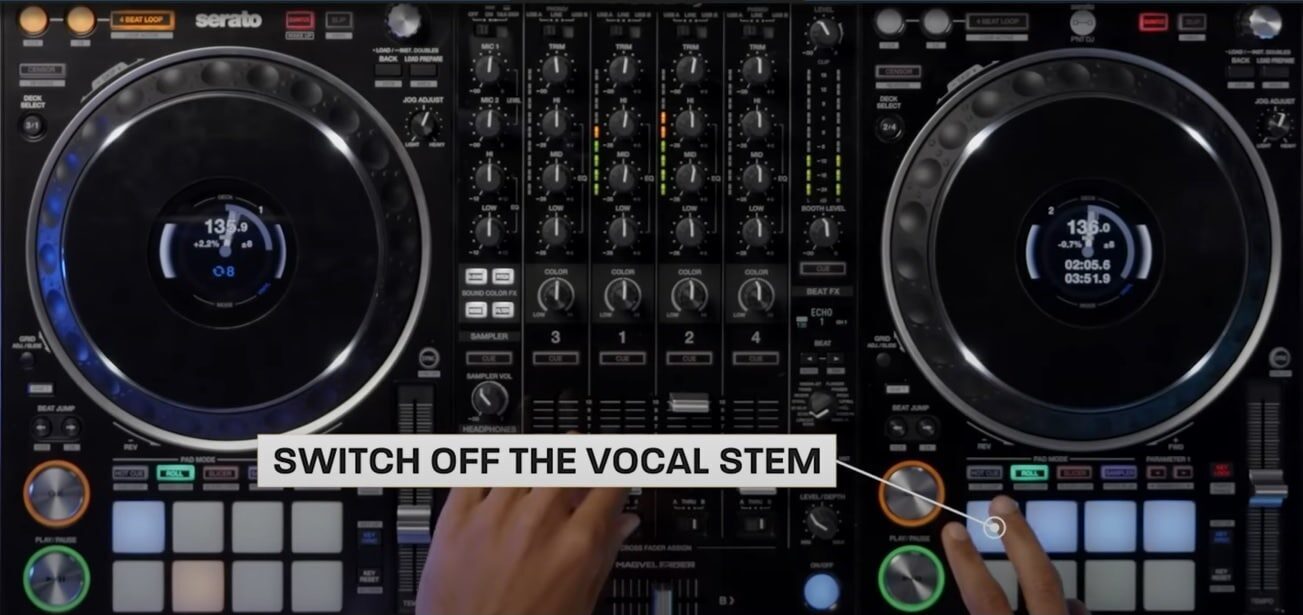
SWITCH OFF THE VOCAL STEM: To round off the mix, once the intro (16 bars) of Baddest Of Them All is finished, we remove its vocal using Serato Stems and unloop Super Freaky Girl to let Minaj spit a verse over the beat from the other track.
Then echo out Deck 1 by pulling the upfader down and reactivating the vocal on Deck 2 to allow Baddest Of Them All full air time.
This transition is possible thanks to the creative power of Serato Stems!
Our comprehensive Serato DJ Course goes through all you need to know about using Stems on your controller and covers all the tips, tricks and techniques you need to become a confident Serato DJ!
Check out this FREE taster lesson on EQs & Filter
#2. Same Song Switch Up
Mixing one version of a song into another is as old a trick as they come. But there’s a reason DJs still do it! It’s a surefire way to cause a dance floor riot, especially if version two of the song is a higher-energy remix of version one.
The Gear
Pioneer DJ DDJ-FLX4 running Rekordbox.
The Tracks
Deck 1: DJ Fresh – Gold Dust (Shy FX Remix)
Deck 2: DJ Fresh – Gold Dust (Tsuki Remix)
The Technique
Lift the set’s energy by going from the commercial drum & bass sound of the Shy FX remix into the mosh-pit vibe of the Tsuki Remix.
How it’s done
ALIGN THE VOCALS: First, get the BPMs to match, then align the vocals in the headphones so they play simultaneously.
Next, drop out the bass from the Tsuki Remix by fully twisting its low EQ pot for Deck 2 fully to the left. Now, when it comes in it won’t clash with the bassline of the Shy FX Remix on Deck 1.
ACTIVATE SMART COLOUR FX: Activate Smart CFX and choose the VAPORIZE option.
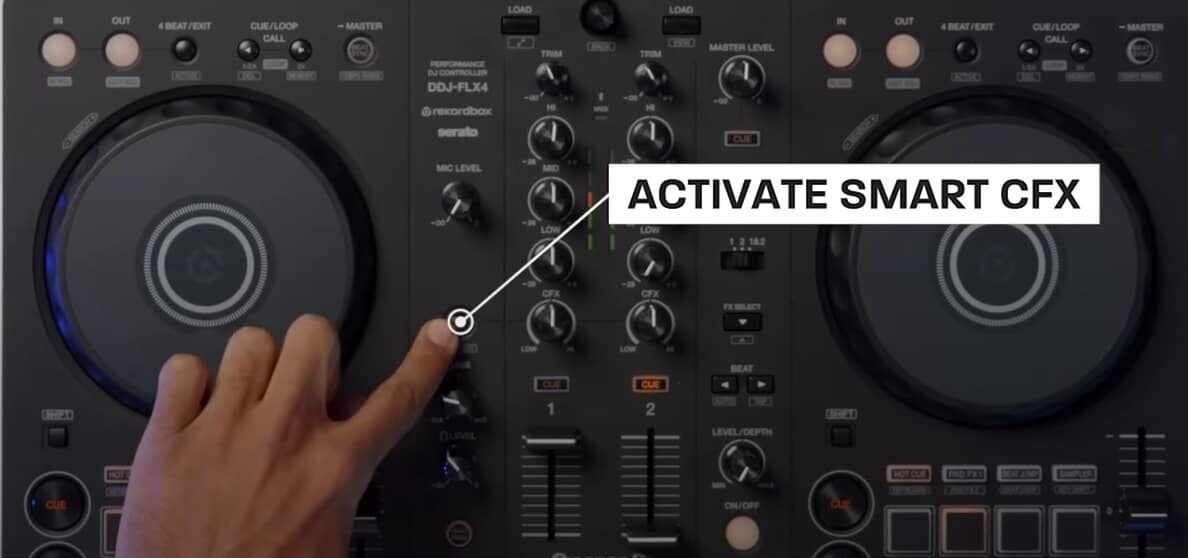
Hot cue Deck 2 to start from its initial vocal.
As the chorus begins on Deck 1, drop in Deck 2 so the same chorus plays in phrase on both decks.
At the start of the second instance of the chorus, raise the upfader for the Tsuki remix over the course of 4 beats.
BRING IN THE LOW END / SMART CFX TO TRANSITION: Once the upfader on Deck 2 is fully open, slowly bring in its bass by twisting the Low EQ pot to the right while simultaneously sweeping the CFX pot of Deck 1 to the right.
This activates the VAPORIZE Smart CFX, creating a high pass of energy to consume the Shy FX remix, making its bass drop out so the two don’t clash.
Once the bass on Deck 2 has dropped, finish twisting the CFX pot for Deck 1 and slowly lower its upfader. The Shy FX remix will disappear within the same wave of energy created by VAPROIZE smart colour effect.
The transition ends with the chopped-up bassline of the Tsuki Remix taking the reigns.
Using the Smart CFX is a DDJ-FLX4 hardware exclusive. Our FLX4 Course has all you need to know about starting out as a DJ and taking advantage of those insane Smart effects!
Check out the FREE lesson Smart Fader Tutorial
#3. Loop Cutting
These days, you don’t need to use a traditional blend to mix tracks together. Mixing things up with just an element from a track can have a real impact. And sometimes a fraction of even that works wonders!
Using a loop to mix can be a great resource for switching genres, as you can set the loop to create a new BPM.
The Gear
Pioneer DJ XDJ-XZ running a standalone version of Rekordbox.
The Tracks
Deck A: Fred Again.. – Kammy (Like I do)
Deck B: Biscits – Me & U
The Technique
We create a loop and cut it down a fraction whilst in the mix. We then re-loop it to its original size and back down again to create a unique pattern that builds energy.
In this transition, we make a loop with Kammy (Like I Do) and use this as a foundation to mix in Me & U.
How it’s done
The mix starts with Kammy (Like I do).
1 BEAT LOOP SET: There is a breakdown with a vocal at about one-third into the track.
Right at the end of that vocal, where all of the instruments have disappeared, catch the word “Babe” from the lyric “Oh, oh babe”
Loop this with a 1-beat loop. This results in a stutter effect “Bay, bay, bay, bay….”
CHANGING THE LOOP FRACTION TO CREATE A PATTERN: Then cut the size of the loop in half to get “B, b, b, b”, and reloop it back to get “Bay, bay, bay.”
Toggle between these two loop sizes to create a musical pattern.
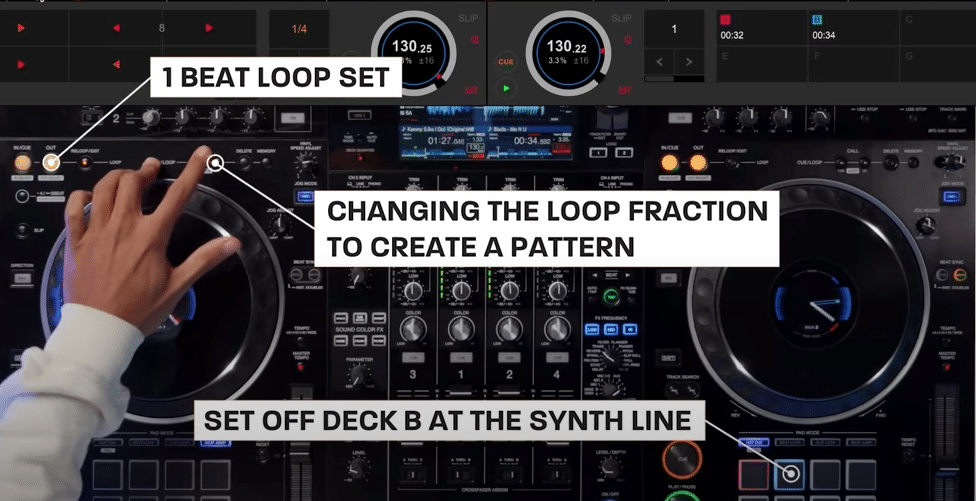
SET OFF DECK B AT THE SYNTH LINE: In between toggling, use a Hot Cue on Deck B to drop Me & U right from where its melodic synth chords play standalone after its 30-second intro.
To gel the mix together, apply a reverb, set to 8 O’clock on the wet/dry dial, to Deck A. This makes chopping the loop in and out more atmospheric.
CUT LOOPS IN AND OUT USING VOLUME FADER: Then, keep chopping the loop in and out with the crossfader while toggling between loop sizes so it stutters “B, b, b, b… Bay, bay, bay….”
Twist the VINYL SPEED ADJUST TOUCH RELEASE for Deck A to about 3 o’clock so it is almost at its loosest setting.
Then, once Me & U is about to drop, simply hit the PLAY/PAUSE button to cause the Kammy loop to wind down right into the Me & U drop.
Pioneer XDJ all-in-ones like the XZ featured in this transition are some of the most popular DJ kit on the market.
If you want to get to grips with Pioneer’s full lineup of all-in-ones, check out our dedicated XDJ Beginner Course to gain confidence with all of their functions.
Try a FREE lesson from the course on EQs
#4. Acapella Pitch Play
A simple but highly effective technique. Pitching down a vocal can drastically change its impact, which can be used to creative effect when set off against the original vocal. Here, Lawrence demonstrates how to get a simple vocal hook to take on new life with a Pitch Play back and forth.
The Gear
Pioneer DJ DDJ-FLX6 GT running Rekordbox.
The Tracks
Deck 1: Notion – Hooked
Deck 2: Fred Again.. – No Love in the Jungle (Original mix)
Deck 3: Fred Again.. – No Love in the Jungle (Acapella)-Pitched down
Deck 4: Fred Again.. – No Love in the Jungle (Acapella)-Normal Pitch
The Technique
An acapella plays over a beat. Using Pitch Play, it is first played at its normal pitch and then pitched down. And then at its normal pitch again, creating a back-and-forth musical contrast.
A four-deck controller or rig is essential for this technique.
How it’s done
Load the No Love In The Jungle acapella into Decks 3 and 4.
Load the original mix into Deck 2 and set a hot cue to the first instance of the lyric “Sailin’ in the chopper. Road killin’ like we vultures…”
Pitch it normally on Deck 4, and pitch it down on Deck 3.
Then, play Hooked as a backing beat on Deck 1 and switch between playing the two differently pitched acapellas to create an interesting back-and-forth.
DECK 1 ACAPELLA PITCHED DOWN / SAME ACAPELLA LOADED ON DECK 1 & 2: Kick off the mix with Hooked playing on Deck 1 as a backing track.
Then stab in the standard acapella vocal from Deck 4, “There’s no love in the jungle”, Once the vocal hook has finished, switch over to Deck 3 and stab in the same pitched-down vocal hook.
Set the standard acapella on Deck 4’s low-end EQ pot to around 10 O’clock to kill some of the bass from the vocal.
Kill off the bass from the pitched-down acapella by twisting its low-end EQ pot completely to the left.
PLAYING DIFFERENT HOT CUE PATTERNS BETWEEN THE 2 DIFFERENT CHANNELS: Ping-pong between the two pitches in time with the beat.
Don’t allow the lyric “There’s no love in the jungle” to complete before shifting over to the other pitch, so you get a pattern that goes “, There’s no, there, there, there’s no..”
Once Hooked starts to crescendo, add a very slight high pass SPACE Sound Color effect to both the pitched-down acapella and Hooked by twisting their Sound Colour pots to around 1 O’clock.
On Deck 2, prepare to set off the original mix of No Love in the Jungle at its hot-cued vocal.
Now switch control of the right-hand jog wheel from Deck 4 to Deck 2 so it is ready to play the original version of the track.
Once a phrase change for Hooked hits, kill both Hooked and the pitched-down acapella by slamming down upfaders 1 and 3.
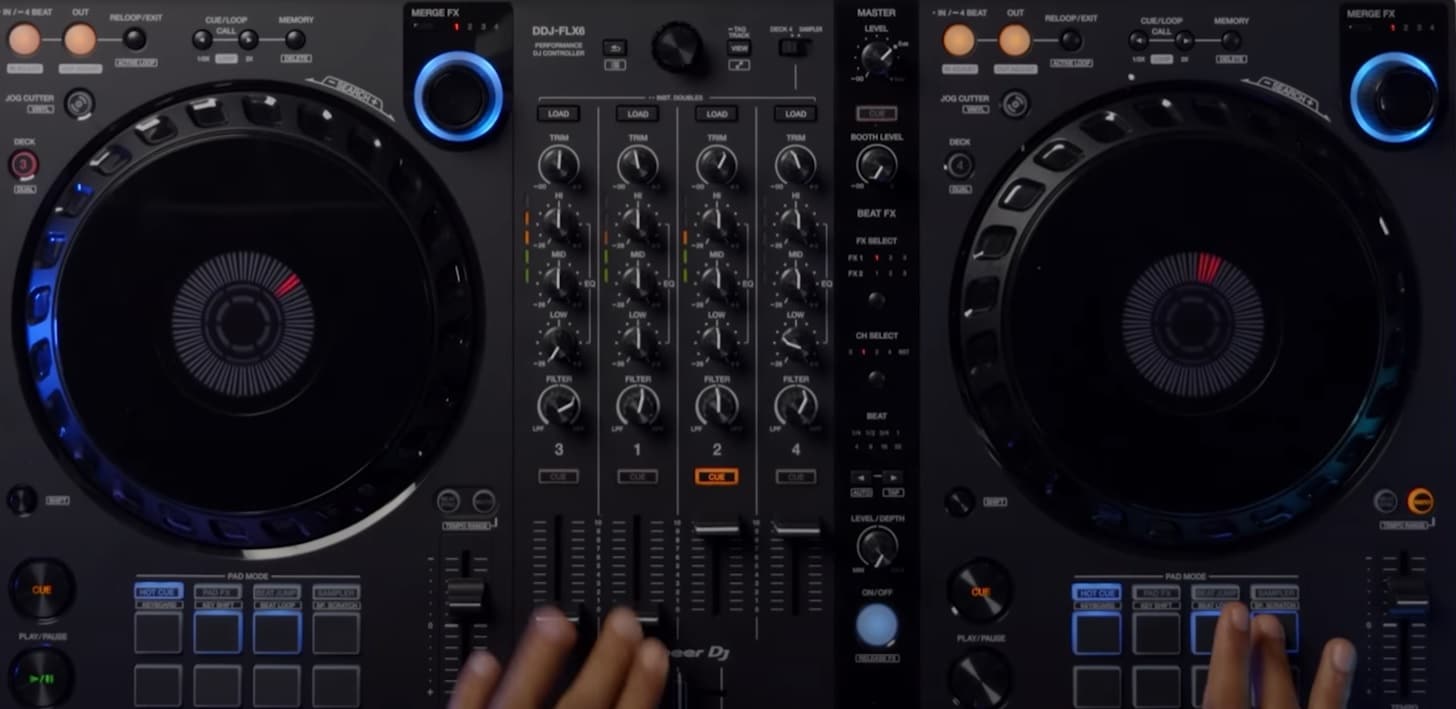
At the same time, play the hot cue for the original No Love in the Jungle “Sailin’ in the chopper. Road killin’ like we vultures…”
The applied SPACE effect creates a small post-fader reverb tail, gelling the overall sound of the transition.
A transition like this is inspired by acapella mixing, which is featured on our Hip Hop Mixing DJ Course. Try this Acapella mixing lesson from the course for FREE Where Does The Acapella Come In?
#5. Polyrhythmic Looping
Using a loop with a 3/2 time signature allows a transition to a higher BPM as the swing and timing of the track being looped changes. Here we transition from house to drum & bass.
The Gear
2 x CDJ-3000 using Rekordbox and a DJM-900NXS2 mixer.
The Tracks
Deck A: MAKJ – Green Light (Short DJ edit)
Deck B: Deekline x Specimen – All The Way Up (VIP).
The Technique
Using a polyrhythmic loop, we take the set into a higher BPM with a swift and satisfying transition.
How it’s done
USING A 3/2 LOOP. THIS ALLOWS US TO TRANSITION TO A HIGHER BPM: As Green Light starts coming to a close, jump back to the first vocal breakdown of the track using a hot cue.
On the vocal, “So show me. Your red or green light,” capture the words “green light” with a 3/2 loop.
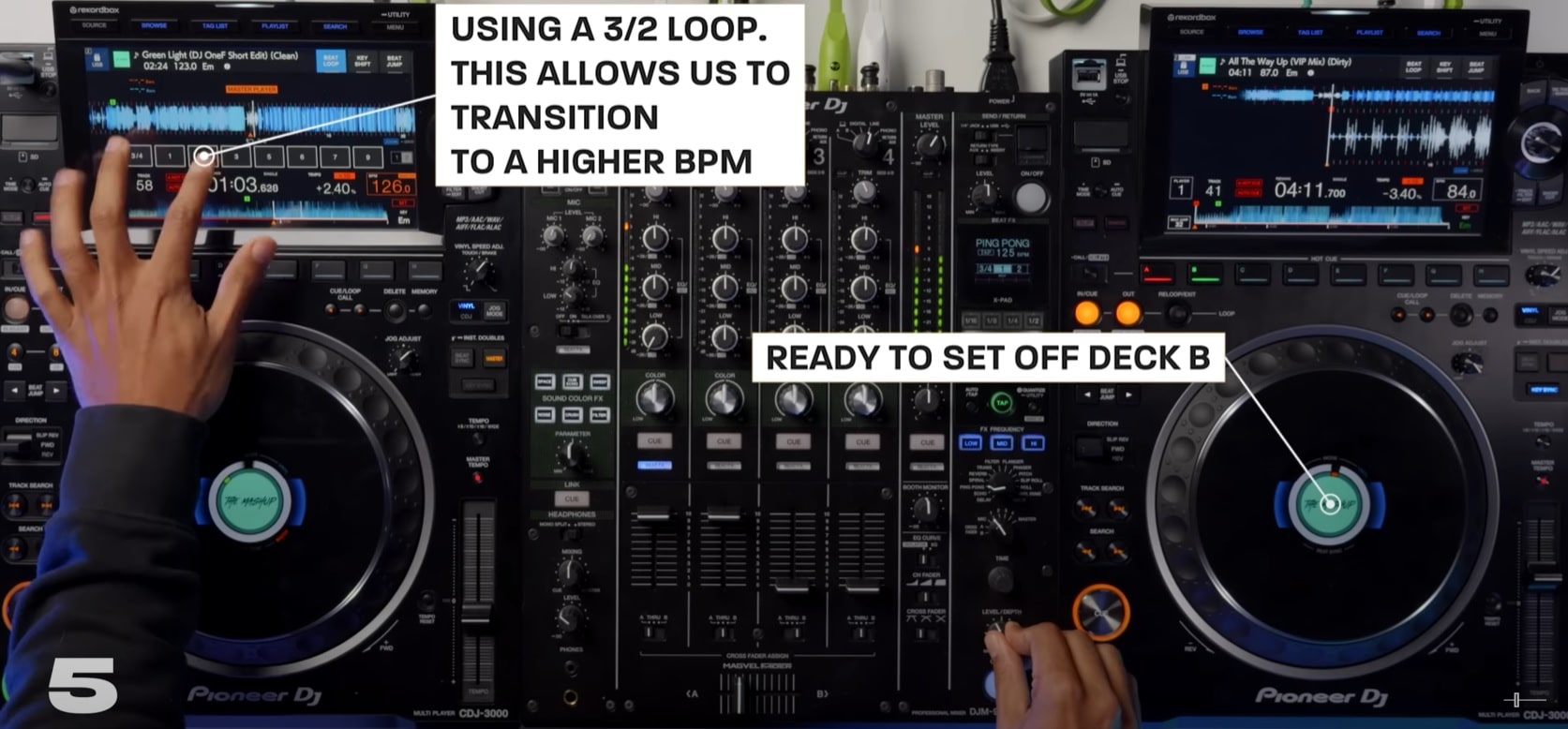
Drop the bass out of the track by twisting the low EQ pot all the way left. Then, apply a 1-beat PING PONG beat effect echo to the loop with the dry/wet dial turned to around 11 O’clock.
READY TO SET OFF DECK B: As the echoing loop establishes, drop in All The Way Up (VIP) with a hot cue, set at the start of its cowboy-film-inspired melody.
Now chop the upfader for Green Light up and down, ensuring you get a clean audio tail each time it echoes.
As an echo pattern begins, slow down the chopping so that Green Light’s vocal stabs play less often.
CHANGING THE LOOP LENGTH: Then, as All The Way Up builds, shorten the loop length of Green Light to 3/4 timing so the vocal loop becomes like a snare roll alongside All The Way Up, adding to the energy of the transition.
Halve the loop again during the build to add even more energy before the drum and bass bassline hits.
Our DJ Transitions Course has 20+ lessons breaking down transitions exactly like these.
Check out the FREE lesson Low to High Genre Transition – 100BPM -125BPM
#6. Toneplay
With this transition trick, get the crowd guessing what’s to come by playing a snippet of the incoming track’s melody in a creative way.
The Gear
Pioneer DJ DDJ-1000SRT running Serato DJ Pro.
The Tracks
Deck A: Mau P – Drugs From Amsterdam
Deck B: Perfecto Allstarz x FreeJack – Reach Out (R3Wire edit).
The Technique
Build anticipation by morphing the synth line melody that the audience is currently hearing into the melody of the incoming track using PITCH PLAY and playing it live with the Performance Pads!
How it’s done
SET TO PITCH PLAY MODE: To achieve the melody of Reach Out using the synth from Drugs From Amsterdam, we first set the Performance Pad mode to PITCH PLAY.
Set a Hot Cue at the start of the isolated lead synth on Deck A. Load this Hot Cue into bank G. This will be the bank used to shift Deck A’s lead synth up and down in semi-tones to create a new melody using PITCH PLAY.
Leave Deck A and B’s upfaders fully open and disable the crossfader by setting it to THRU.
Deck A plays first. Once it gets to the drop, set a 1-beat echo with the dry/wet dial to around 8 o’clock and allow its isolated melody to play for 2 bars before hitting the Hot Cue to repeat those same 2 bars again.
SET OFF DECK B / PLAYING WITH THE ISOLATED SYNTH SOUNDS TO PLAY IN THE MELODY OF THE NEXT TRACK: Cue Reach Out to start from the beginning on Deck B.
Hit PLAY on Deck B after 4 bars of the melody on Deck A.
At the exact same time, start finger drumming with the Hot Cues for Deck A to recreate the well-known Reach Out melody, but with the synth sound of Drugs from Amsterdam.
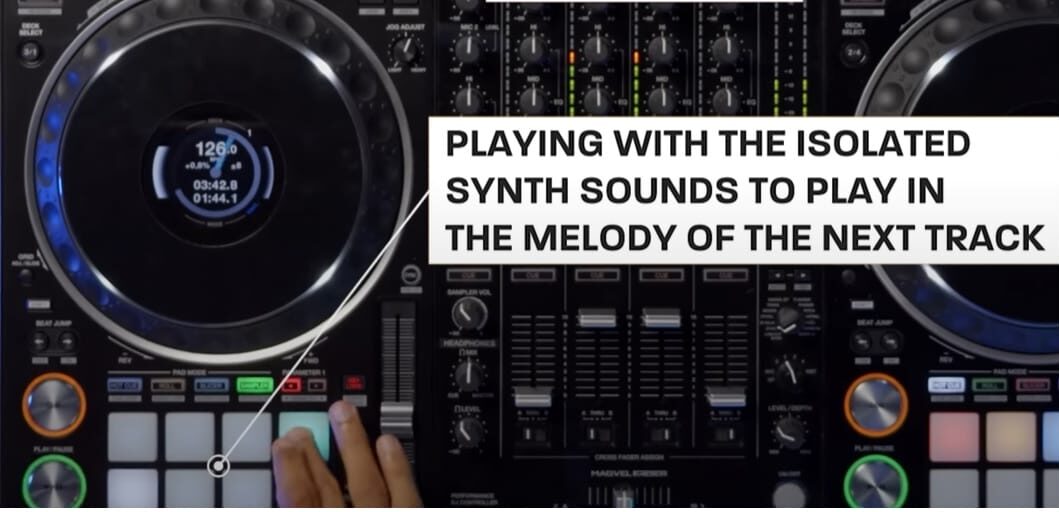
Once the melody of Reach Out starts to play on Deck B, stop finger drumming it on Deck A and pull down the upfader.
PLAYING WITH THE ISOLATED VOCAL SECTION: As Reach Out is playing, reintroduce the isolated vocal for Drugs From Amsterdam by using Serato Stems to isolate the vocal and play it in with the Hot Cue buttons, which have been pre-loaded as follows.
Hot Cue bank D plays back: “Off my face, don’t know where I am…”
Hot Cue bank H plays back: “…Because I got my drugs from Amsterdam.”
Stab at the Hot Cue buttons to build a vocal pattern whilst Reach Out builds to another drop.
This creative technique is found in our Tone Play DJ Course. The course is full of slick ways to play with tone and pitch as an alternative way to mix. Try this FREE lesson from the course: Rock Music Tone Play.
#7. Brake Effect
This technique involves repeatedly using a turntable-style brake on a track to give the mix a hip-hop-inspired twist.
The Gear
Pioneer DJ DDJ-FLX4 controller running Rekordbox.
The Tracks
Deck 1: Crystal Waters – Gyspy Woman (Push3r Remix)
Deck 2: Gorgon City – Go Deep (Club Hack Acapella Intro Edit)
The Technique
Here, Lawrence introduces a musical stop-start pattern by playing a well-known, isolated vocal over a famous melody. He then stops the vocal with a turntable-style brake and instantly reintroduces it with perfect musical timing several times over.
How it’s done
In preparation for this mix, set Hot Cue bank A for Deck 2 to the intro of the track, an acapella of Barabara Tucker singing.
MIXING IN THE LEFT DECK: Make a typical blend during the last phrases of Go Deep.
First, bring in Gypsy Woman with its bass cut by twisting the low EQ pot on Deck 1 all the way left.
Then, swap the basslines by slowly reducing the bass on Go Deep by twisting the low EQ pot on Deck 2 to the left. Simultaneously, introduce bass into Gypsy Woman by twisting the low EQ pot on Deck 1 slowly to the right until it reaches the centre.
JUMP TO FIRST HOT CUE: Once the melody for Gypsy Woman begins, Hot Cue back to the intro of Go Deep on Deck 2.
The incredibly well-known acapella raises the energy as it plays over the equally famous Gypsy Woman melody.
To achieve a musical pattern with this isolated vocal, the rest of the Hot Cues for Deck 2 should be set as follows:
Hot Cue bank B is the second instance of the word “Deep”
Hot Cue bank C is “..Down inside”
Hot Cue bank D is the concluding phrase “Deep down inside.”
USING A SLOW PAUSE / PLAY TO CREATE A BRAKE EFFECT: With these Hot Cues, you can play around with the phrasing of the Deep Inside vocal.
Set the VINYL SPEED ADJUST TOUCH RELEASE to Slow, then introduce the acapella and vinyl-brake it for effect by pressing PLAY/PAUSE on Deck 2 over the top of the Gypsy Woman melody as it builds.
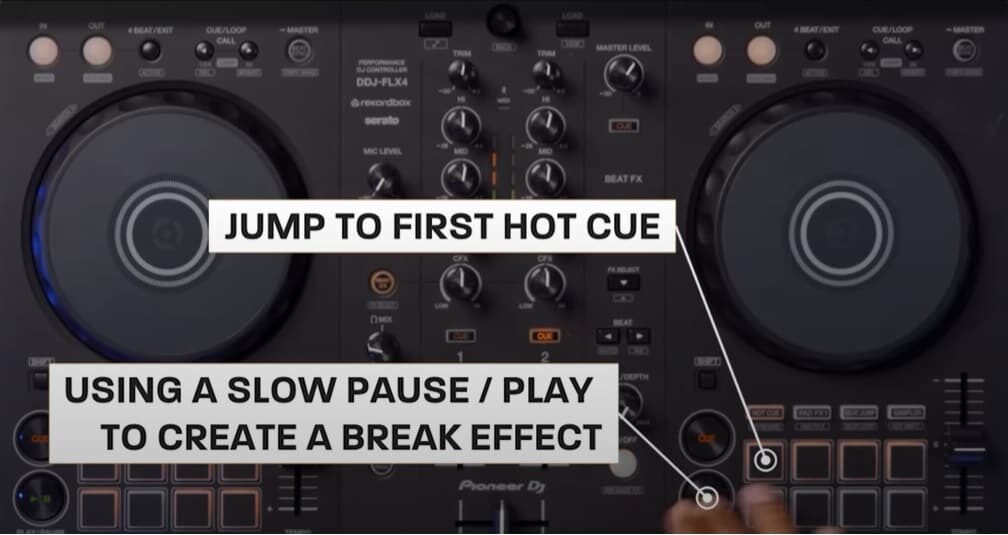
As Gypsy Woman comes close to its drop, trigger Hot Cue D so the lyric “Deep down inside.” plays nicely into it for a tidy handover.
We used Rekordbox for this technique, a perfect match for the DDJ-FLX4. Our dedicated Rekordbox Beginner Course shows you around the software so you can make the most of its powerful abilities.
#8. Slip Mode
Slip Mode gives DJs the freedom to flex their creative muscles! Scratch, stutter, or brake a track, then return to its uninterrupted playing position.
The Gear
Pioneer DJ XDJ-XZ all-in-one running a standalone version of Rekordbox.
The Tracks
Deck A Sophie Tucker – Drinkee (Josh Summit + Vintage Culture Remix)
Deck B: Wildchild – Renegade Master (Kingcat Bootleg).
The Technique
Set off a perfectly in-phrase long blend and use Slip Mode to Hot Cue jump around that same track’s isolated vocal getting the best of both worlds; a traditional long blend with a contemporary acapella mash-up, all played from the same deck!
How it’s done
SET OFF DECK B / ACTIVATE SLIP MODE: Towards the end of Drinkee, Remove the bass from Renegade Master by twisting the low EQ pot fully left on Deck B, then press PLAY/PAUSE to begin a perfectly phrased blend in.
Straight after starting the track, put Deck B into Slip Mode.
Whilst the mix is establishing, make quick stabs at the isolated Renegade Master vocal, which should be saved to Deck B’s Hot Cue banks as follows:
Bank C with the isolated lyric “Back once again for the renegade master.”
Bank D with the isolated lyric “D four damager, power to the people.”
This isolated vocal appears about halfway into the track, so the Hot Cues should be made from here.
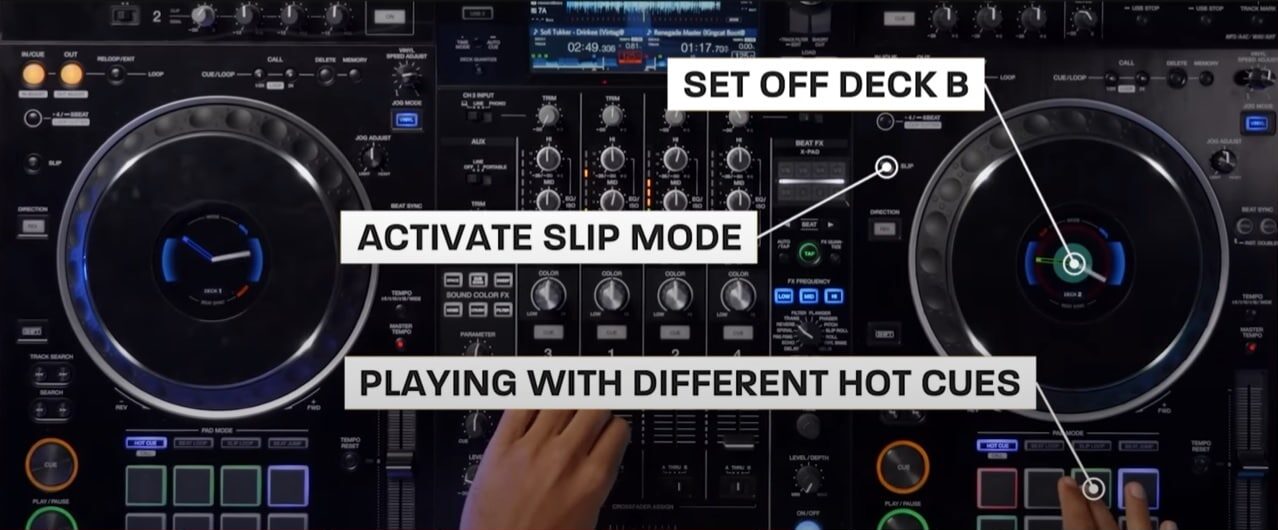
MIX OUT OF DECK A: Once the Hot Cues from Deck B have played a couple of times, the Renegade Master vocal naturally begins to fade into the track. Here, chop the fader for Deck A up and down to give the mix a nice choppy texture.
As Renegade Master is about to drop, add bass to the track by twisting the low EQ pot for Deck B to the central position. Then, Remove the low end from Drinkee by twisting the low EQ pot for Deck A fully left and engage a high-pass SPACE sound colour effect, putting the pot to about 4 O’Clock.
Now, whilst the fader is chopping, some nice reverberated elements of the track playback. Do this until Renegade Master drops, then slam down the upfader for Deck A.
The engaged sound colour effect will create a nice reverberation tail, smoothing out the mix.
Slip Mode is a major creative function of Pioneer DJ controllers and CDJs.
Our CDJ masterclass covers this and everything you can expect to find on their club-standard gear. Packed with hints, tips, tricks and detailed walkthroughs to help you make full use of Pioneer’s flagship CDJs and DJM equipment.
#9. Loop Tightening
Since the digital revolution of the early 00s, loops have become an essential part of DJing! Looping has since advanced, become more creative, and quickly become a staple in DJ sets.
The Gear
Pioneer DJ DDJ-FLX6 running Rekordbox.
The Tracks
Deck A: Joshwa – 212
Deck B: Chris Lorenzo – California Dreamin’ (Ship Wreck Remix)
The Technique
One deck plays a long loop as a backdrop for a short loop playing on the other deck. The short loop gets rhythmically shorter and shorter to create energy.
Then, the longer loop is released, allowing that track to drop, and just before, the shorter loop tightens into a revving frenzy, adding to the build of the drop!
How it’s done
212 is the track used to create a short loop. California Dreamin’ is the track used for the long loop.
CUE & PLAY DECK A: Starting at the 212 lyric “What you gon’ do when I appear?”, slowly introduce a 16-beat loop of California Dreamin’, with its bass taken out by twisting the low EQ pot of Deck B fully left.
For a smooth blend, start lowering the bass of 212 by twisting the low EQ pot for Deck A fully left. At the same time, bring the bass up on California Dreamin’ by twisting the low EQ pot for Deck B to its central position.
SET A 1-BEAT LOOP: Set a 1-beat loop on 212 during the vocal at the word “I”, so it loops the lyric to say “I, I, I, I….”
Then halve the loop so the “I” becomes more frequent “I, I, I, I….”
MANUALLY TIGHTEN LOOP WITH JOG WHEEL: Manually tighten the 212 loop by gently nudging the jog wheel on Deck A, so the vocal becomes partially cut off.
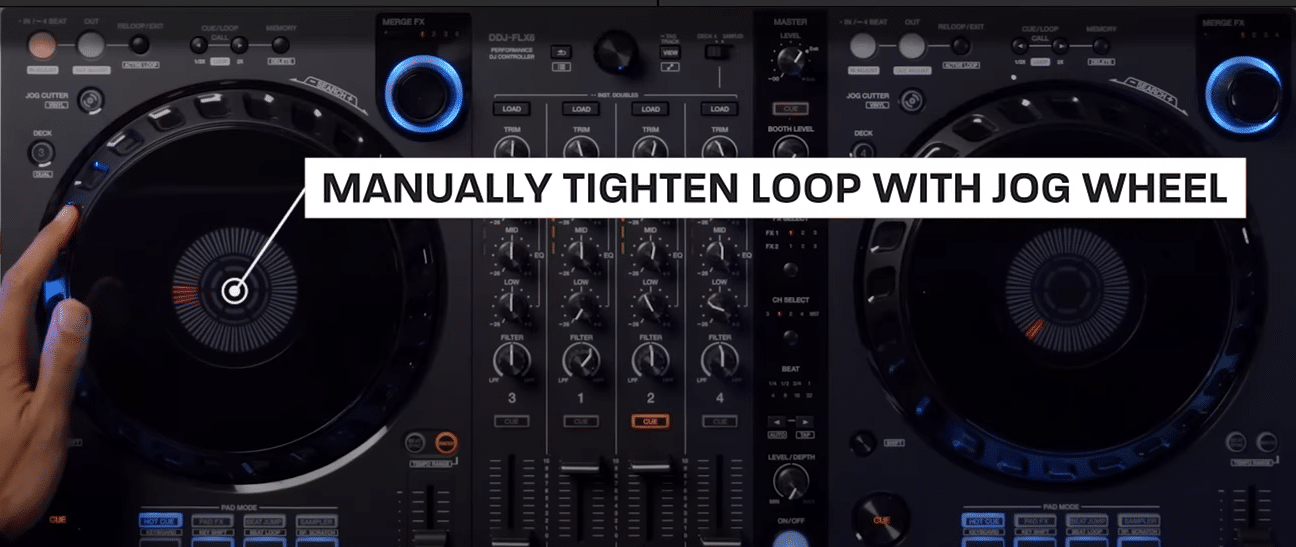
CUT WITH THE CROSSFADER TO CREATE PATTERN: Now, as the stuttering has intensified, use the crossfader to cut the audio in and out and make patterns with the loop.
EXIT LOOP ON DECK B: Release the 16-beat loop of California Dreamin’ so the track starts building towards its drop.
USE SLOW PAUSE / PLAY BRAKE EFFECT ON THE LOOP: Stop cutting the 212 loop to introduce some stop-starting with a brake effect.
This is done by setting the VINYL SPEED ADJUST TOUCH RELEASE in settings to slow and then rhythmically pressing PLAY/ PAUSE for 8 beats in time with the beat.
Go back to fader cutting the loop for the last 4 beats leading into the drop of California Dreamin’, followed by a final brake effect to end 212.
Rekordbox is currently the number one software choice for DJs, so knowing your way around it is crucial for most professional set-ups. Check out this FREE lesson from our Rekordbox Intermediate Course on using the Trans Beat Effect
#10. Pitch Play With Looping
Another contemporary use of loops is to introduce a playful musicality to the mix by pairing a loop with Pitch Play. Changing the pitch of a vocal can have a dramatic effect which can really switch things up!
The Gear
2 x Pioneer DJ CDJ-3000s with a Pioneer DJ DJM-900NXS2 mixer.
The Tracks
Deck A: Vandal On The Track – Hollaback Girl
Deck B: Pickle – La Fiesta
The Technique
Loop a well-known vocal over the build of an incoming track. With Pitch Play, take that vocal up in pitch to the point where it sounds helium filled!
Then return it to normal to play nicely into the next track’s drop. Awesome for getting a mix to really take off!
How it’s Done
SET OFF DECK A: A smooth blend is started towards the end of Hollaback Girl immediately after the main vocal ends. La Fiesta comes in with its bass turned off. Gwen Stefani’s famous vocal hook continues to play throughout this initial blend.
Halfway through the opening phrase of La Fiesta, switch the basslines to allow the second half to gain power before dropping into its salsa-inspired breakdown.
JUMP TO ACAPELLA SECTION OF THE TRACK / APPLY PING PONG FX: Alongside switching the basslines, jump to the acapella intro on Deck A and apply a 1-beat PING PONG beat effect echo with the dry/wet dial tuned to around 10 o’clock.
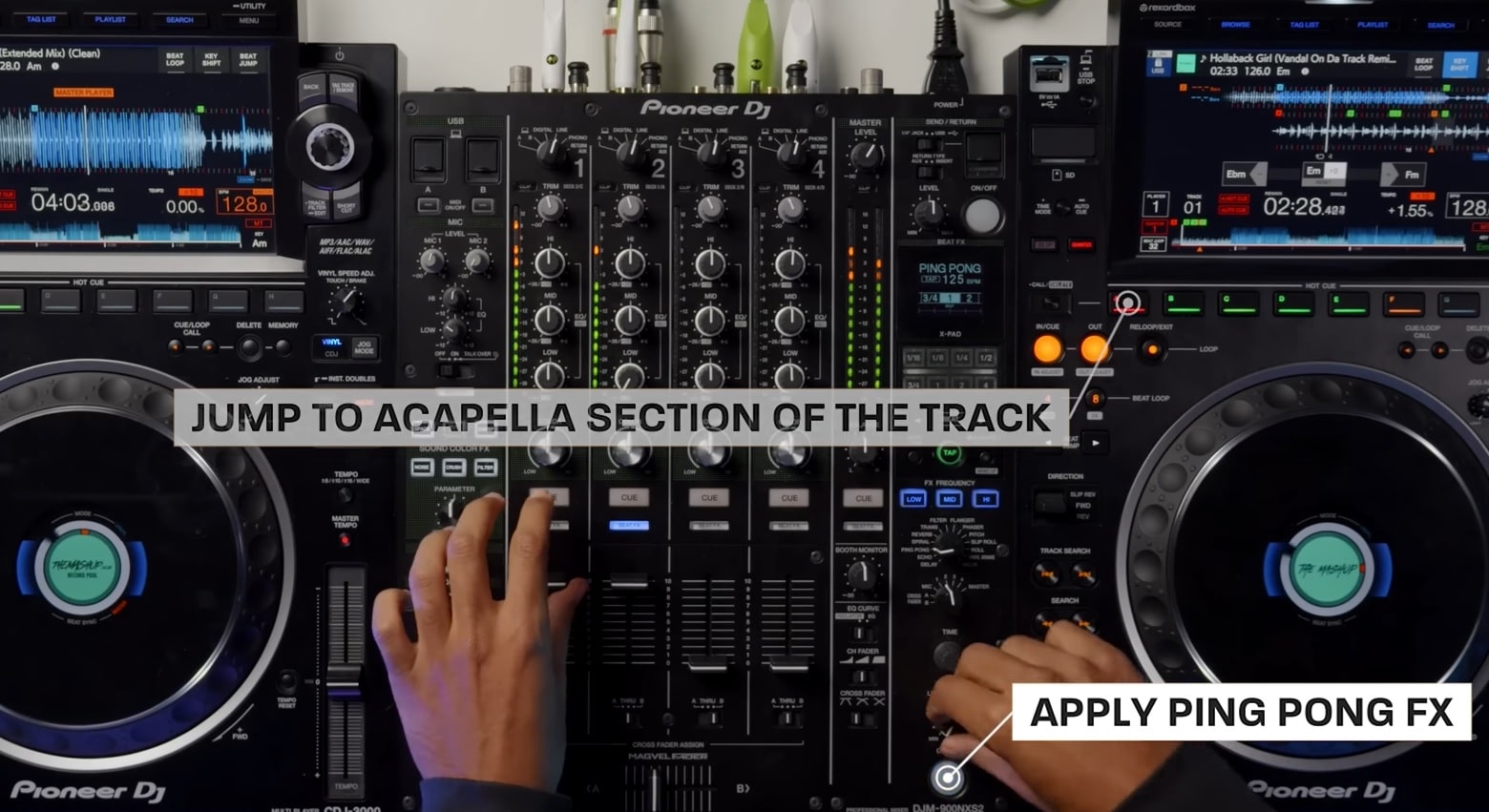
During La Fiesta’s drop lead-in snare roll, deactivate the echo on Deck A.
ACTIVATE LOOP: Once La Fiesta’s salsa melody unfolds for 8 beats, set a 4-beat loop on Deck A, so the “Feet like this” lyric is heard repeating over the 8 beats.
SWITCH BETWEEN DIFFERENT LOOP LENGTHS: Then, when the melody gets into full swing, halve the acapella loop on Deck A so we just hear “Feet like.”
Then double the loop after 8 beats to reintroduce the whole phrase “Feet like this.” Then halve it again, and double it again after the next 8 beats.
Halve the acapella loop again as La Fiesta revs up for a drop into some Latin-tinged house music vibes.
USE KEY SHIFT TO GO UP IN PITCH: Pitch up the acapella so that with each repetition of “Feet like”, the vocal octave goes up one.
Then return the vocal octave to normal whilst re-looping the lyric “Feet like this” right before La Fiesta’s house vibes hit.
After six bars play, apply a 1-beat PING PONG echo to the acapella on Deck A and reintroduce the vocal from its introduction.
Twist the wet/ dry knob of the echo to about 2 o’clock whilst the vocal is in play, then, once “feet like this” has just played again, sharply cut the upfader of Deck A down to cause the vocal to echo off.
Loops have become crucial to the DJ scene, mainly in house and techno music, where they are used to nail long blends and for layering tracks into one another as a mixing technique.
Learn about looping in our House Mixing DJ Course and check out our FREE lesson on Layering.
#11. Sample Switch Up
So much of modern music is built on sampled elements from past tracks. Inspire your audience with a mix that throws back a loved anthem to its sampled roots by playing the two side-by-side!
The Gear
Pioneer DJ DDJ-1000SRT running Serato DJ Pro.
The Tracks
Deck A: Wuki – Edge Of Seventeen
Deck B: Destiny’s Child – Bootylicious
The Technique
Play the ever-popular Bootylicious into a house remix of its sample track, Stevie Nicks’ Edge of Seventeen. This transition uses Serato Stems and key shifting to allow R&B to flow into house music with a steady build.
How it’s done
SWITCHING UP THE SAMPLE THAT IS USED IN DECK B TO TRANSITION / PITCH UP TO MATCH KEY OF LEFT DECK: Drop Bootylicious, then, at the lyric, “Baby, can you handle this?” key shift the track on the second and third instance of the lyric “baby”.
The two tracks are now harmonically matched for mixing in key.
INSTRUMENTAL ECHO OUT: Isolate the lyrics on Deck B using Serato Stems. Then sync Deck B to Deck A, which is about to play Edge Of Seventeen.
SET OFF DECK A: Hot Cue and drop Deck A from the famously sampled riff. Slow down the BPM of Deck A to 104.1 to match the native BPM of Deck B.
Then, on Deck B, hot cue jump back to the chorus and allow it to play once, then jump back and play it again.
SYNC AND BRING UP BPM: Slowly start to bring the BPM of Deck A up; Deck B’s vocal will change with it as the two are beat-synced. Then apply a 1-beat echo to the vocal on Deck B, set at around 10 o’clock on the wet/dry dial.
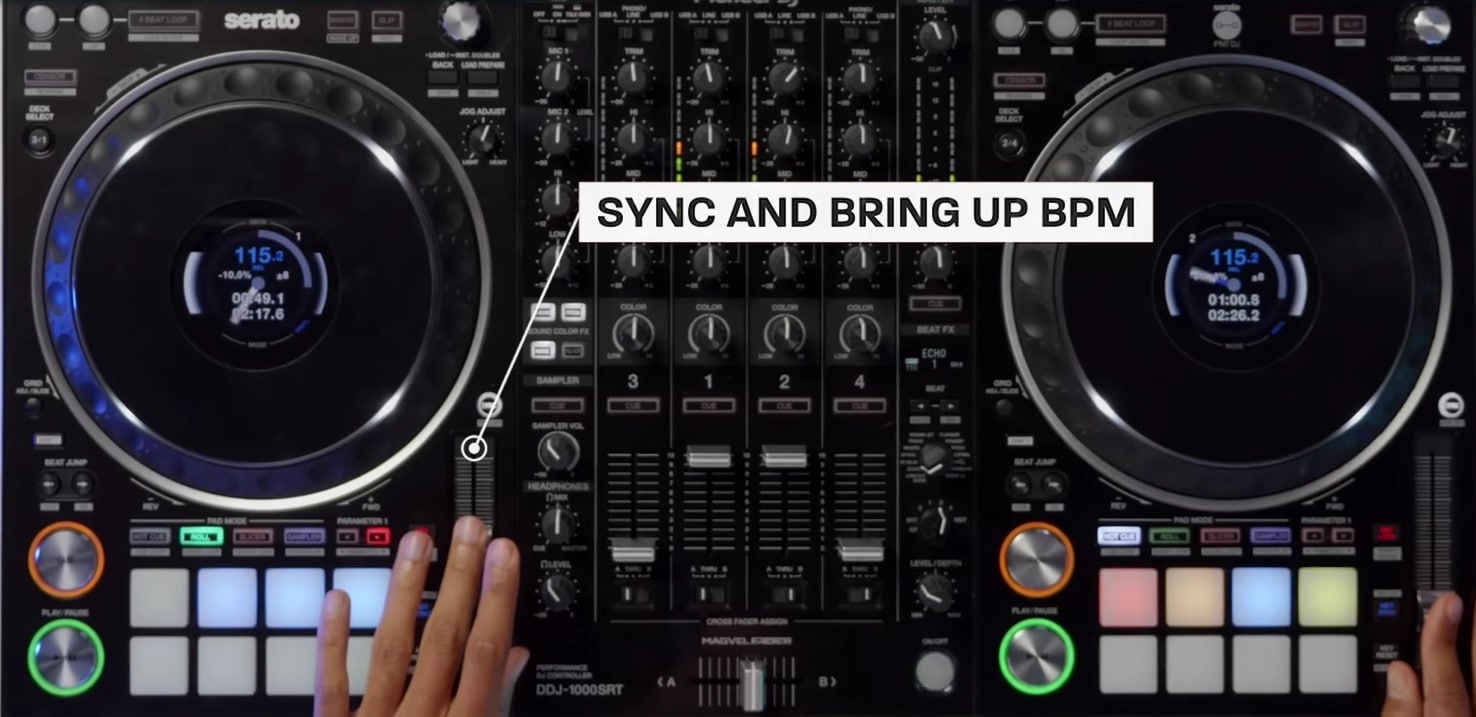
Slowly bring the BPM up to 126 over 16 bars until Edge of Seventeen is about to drop, then slam down the upfader for Deck B and let that vocal tail off with an echo.
Jumping from one BPM to a massively different one can be daunting. But with the right tools and tricks, you can play anything! Our DJ Transitions Course is here to help you learn how to go from any track or genre into any other with style!
#12. Wide Syncing
Wide Sync is great for bringing drastically varying BPMs together. Great for completely changing directions in a set without it sounding jarring!
The Gear
2 x Pioneer DJ CDJ-3000s running Rekordbox and a DJM900NXS2 mixer.
The Tracks
Deck A: Disclosure ft. Eliza Doolittle – You & Me (Flume Remix) Westen + Local Singles Edit
Deck B: Disclosure ft. Eliza Doolittle – You & Me (Master Error x Amplify Bootleg)
The Technique
Mix a house remix of Disclosure’s You & Me into a drum and bass version with a BPM hike over only one phrase, seamlessly taking the set into new territory!
How it’s Done
SYNC APPLIED AND TEMPO RANGE SET TO WIDE: Drop the Flume remix first.
Then Synchronise the two decks and set the tempo range to WIDE to allow for a drastic shift in BPM. The starting tempo is 125 BPM.
PLAY DECK B AND START TO MIX OVER: In the last third of the Flume remix, there’s a nice breakdown which coincides with a build on the intro of the Master Error x Amplify bootleg.
Set off Deck B’s build as the breakdown on Deck A starts.
USING EQ AND SOUND COLOR FX: Mute the bass on Deck A by twisting its Low EQ pot fully left, and apply the SPACE sound color effect with the pot twisted to around 1 o’clock.
SET LOOP ON DECK A: Set a 16-beat loop during the breakdown of the Flume remix on Deck A so it can continuously play over the build to the drop of Deck B.
BRING UP BPM / BEAT SYNC ACTIVE: Now bring the tempo of Deck A up from house territory into drum & bass at around 183 BPM.
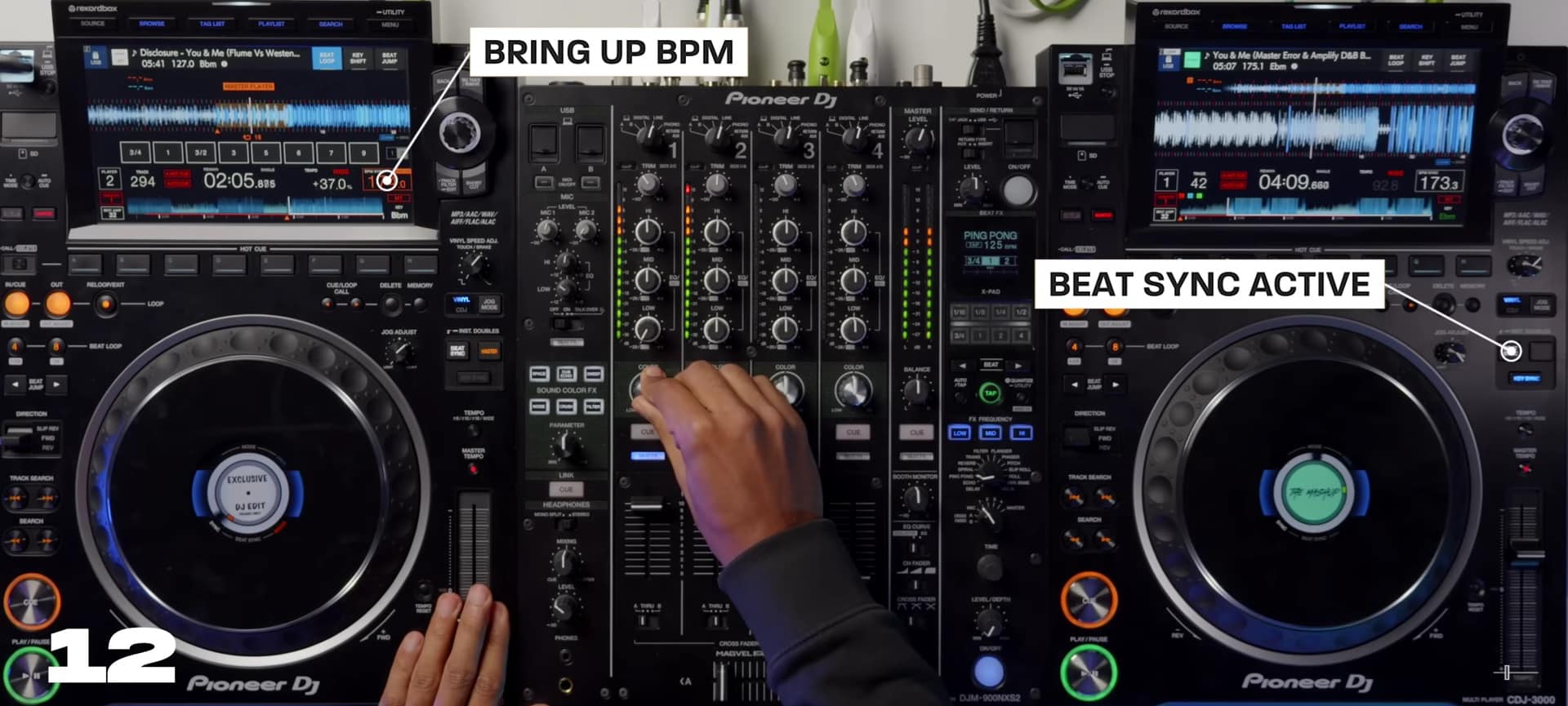
As Deck B is beat-synced to Deck A, this will automatically rise with it. Raise this over 16 bars so it is at the correct drum & bass tempo when Deck B drops. Slam down Deck A’s upfader as Deck B drops so it exits the mix cleanly.
With you every step of the way
We hope these techniques have inspired you to grow your skillset. Whether you want to learn how to become a DJ or have been doing your thing for years and want to brush up on your skills, Crossfader is here to support you!
No matter what equipment you use, or what skills you want to learn, we’ve got you covered with our Complete DJ Package!
Get lifetime access to all our easy-to-follow, industry-certified DJ lessons, plus all the content and support that you need to make it in the business!
Complete DJ Package members also get exclusive access to loads of extras, including more of our popular hacks and tips, a global online DJ community, tech support, career advice and even access to the Crossfader team via real-time Q&A and live mix sessions!
Learn more about this amazing opportunity to catapult your skills and success by clicking the picture below!
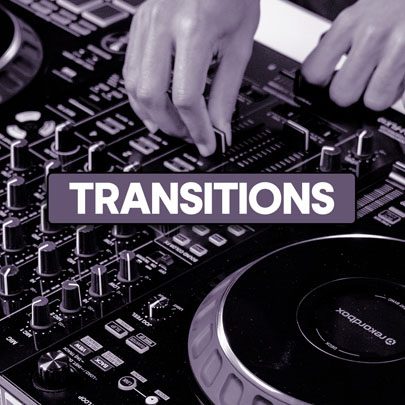
DJ Transitions Course
8.5 hours
35 lessons
Creative
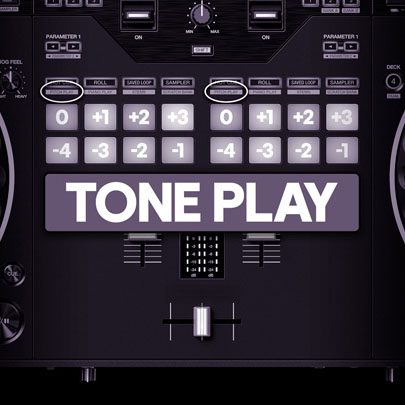
Tone Play DJ Course
2 hours
24 lessons
Creative
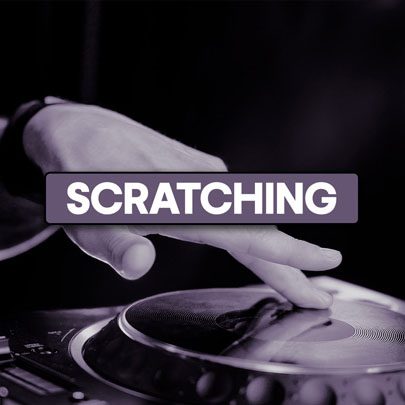
The Ultimate Scratching Course
5.8 hours
63 lessons
Creative

Complete DJ Package
835 hours
1300+ lessons
Creative
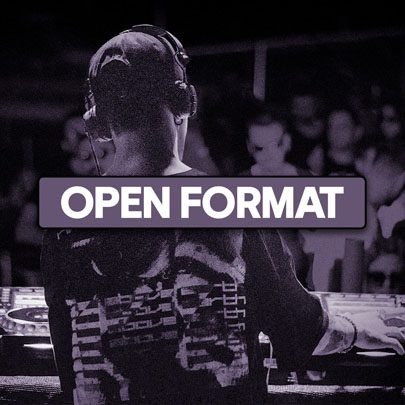
Open Format DJ Course
3.25 hours
64 lessons
Creative

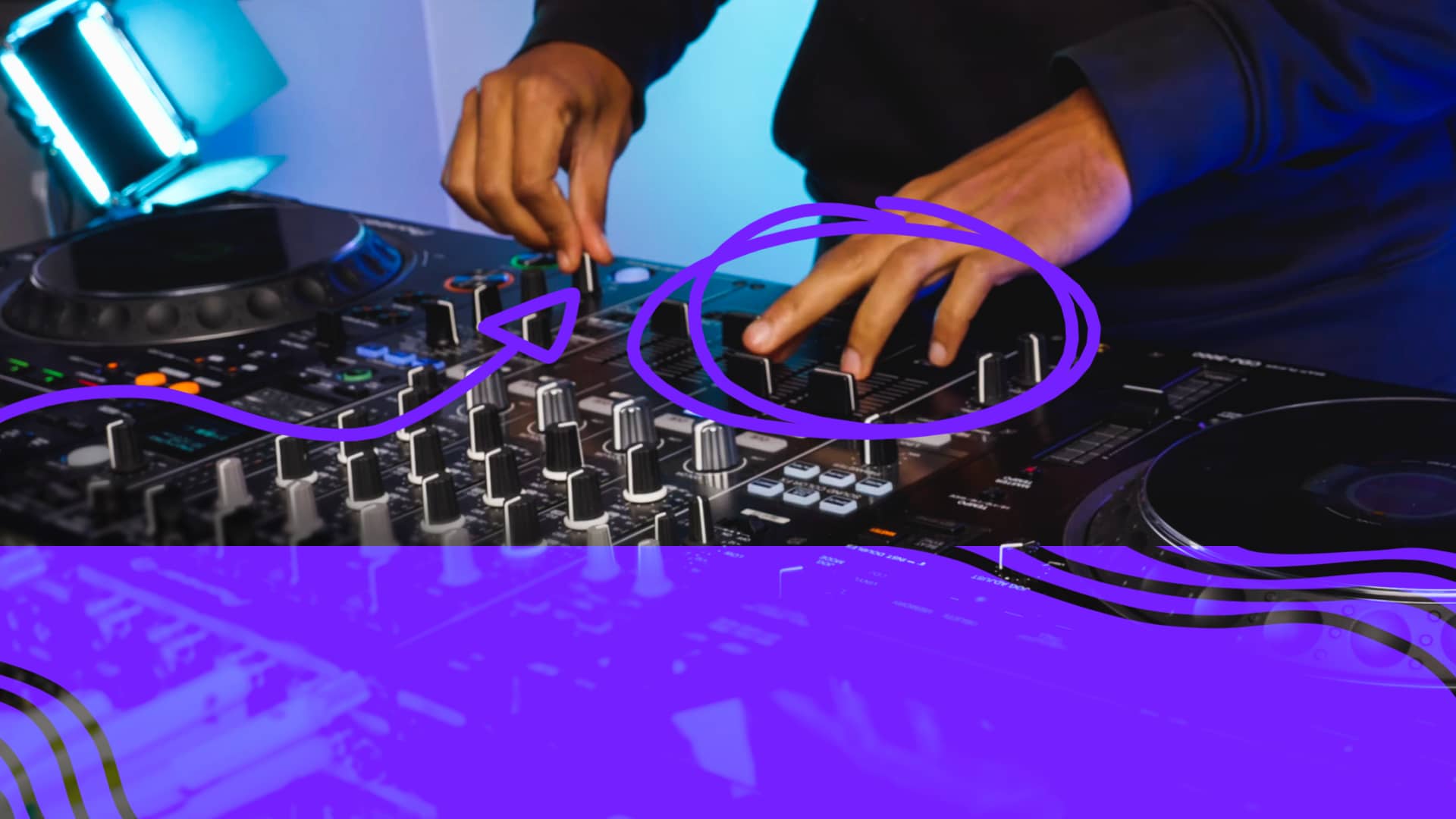

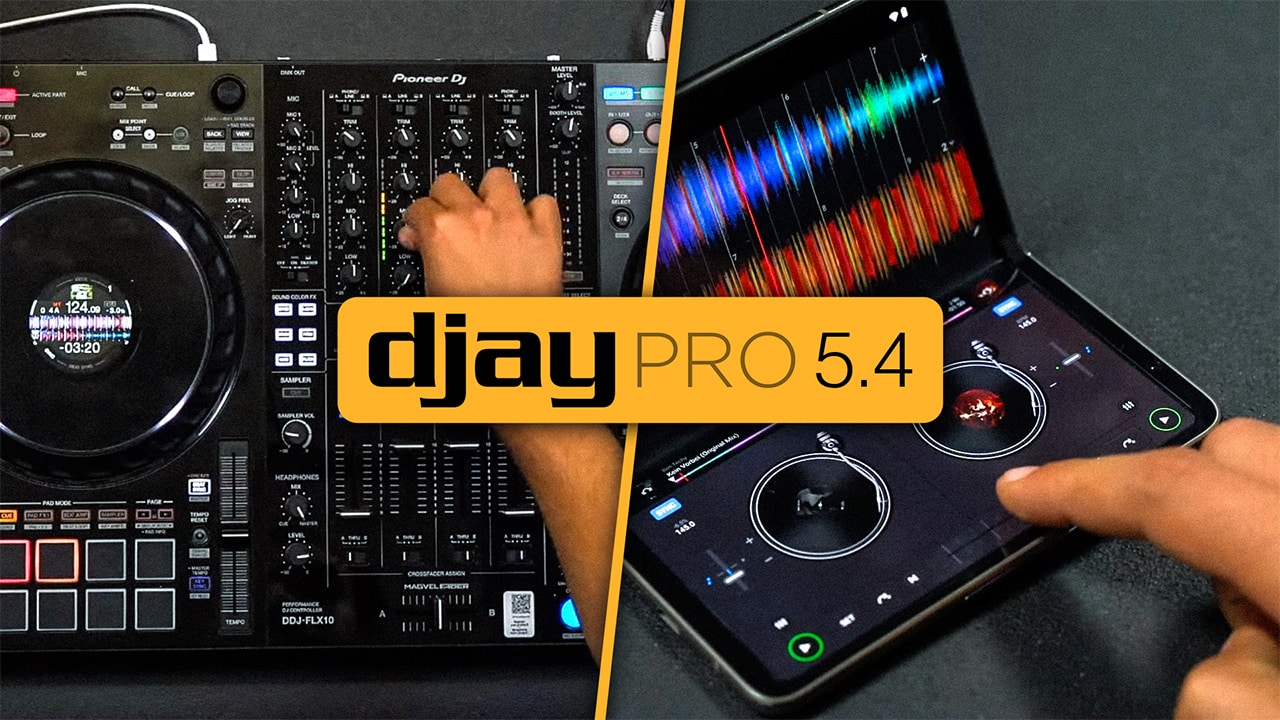

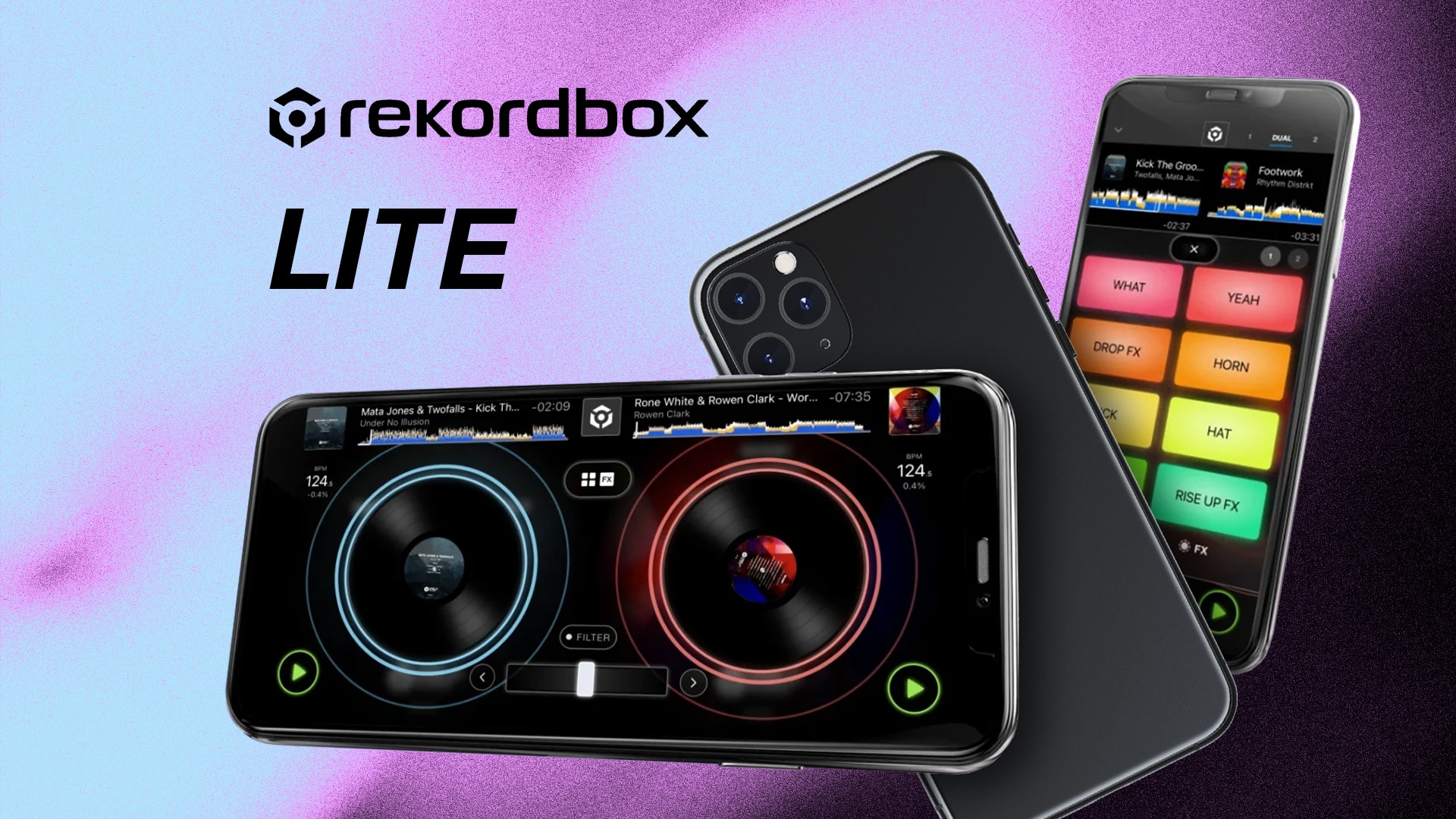

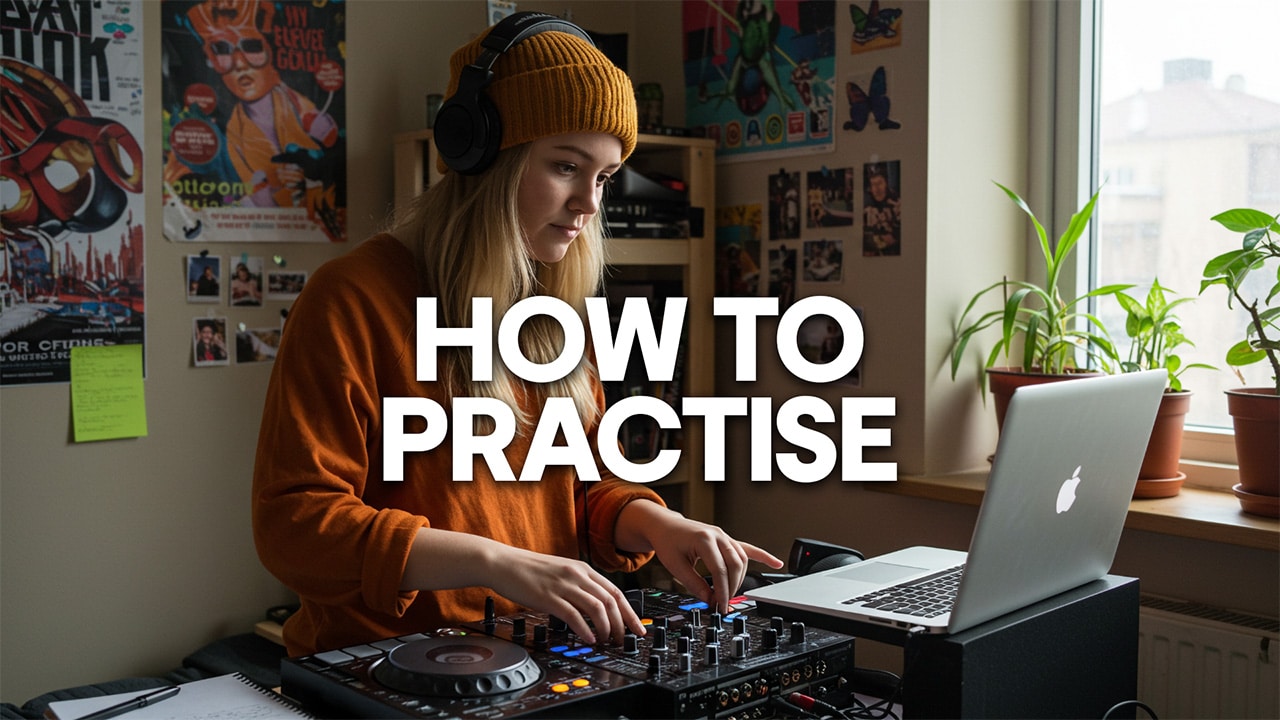
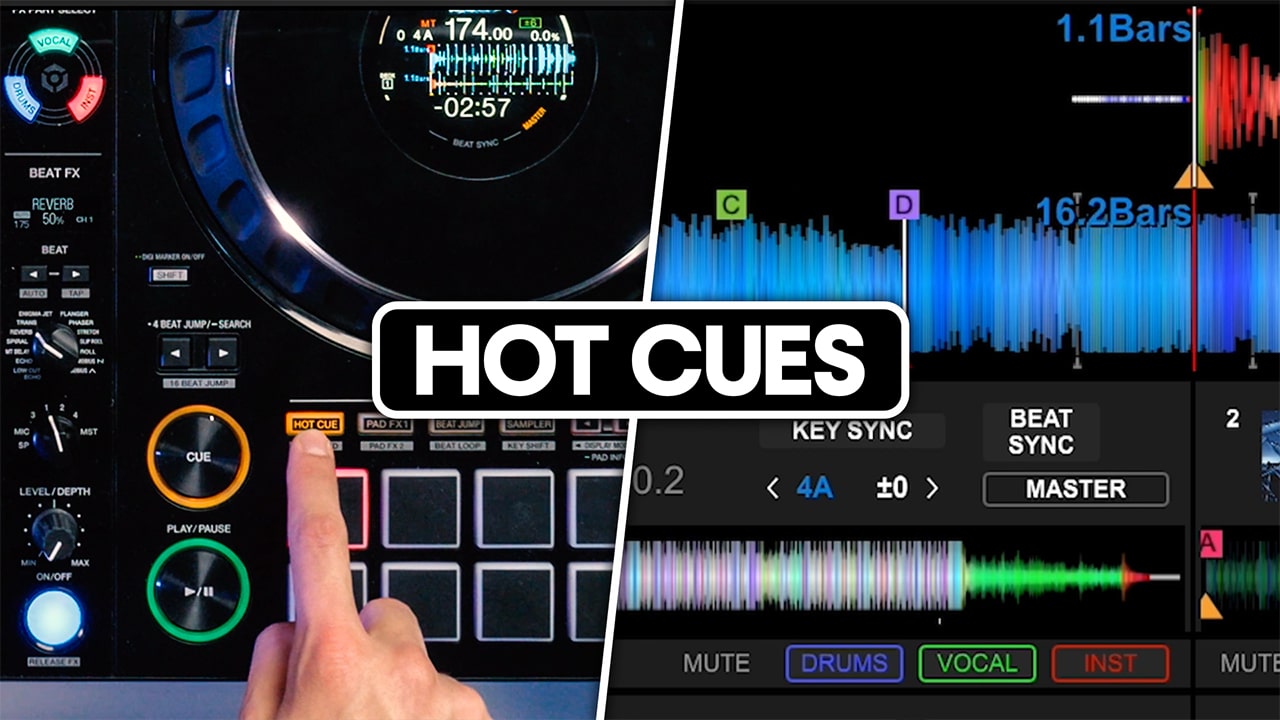
0 Comments